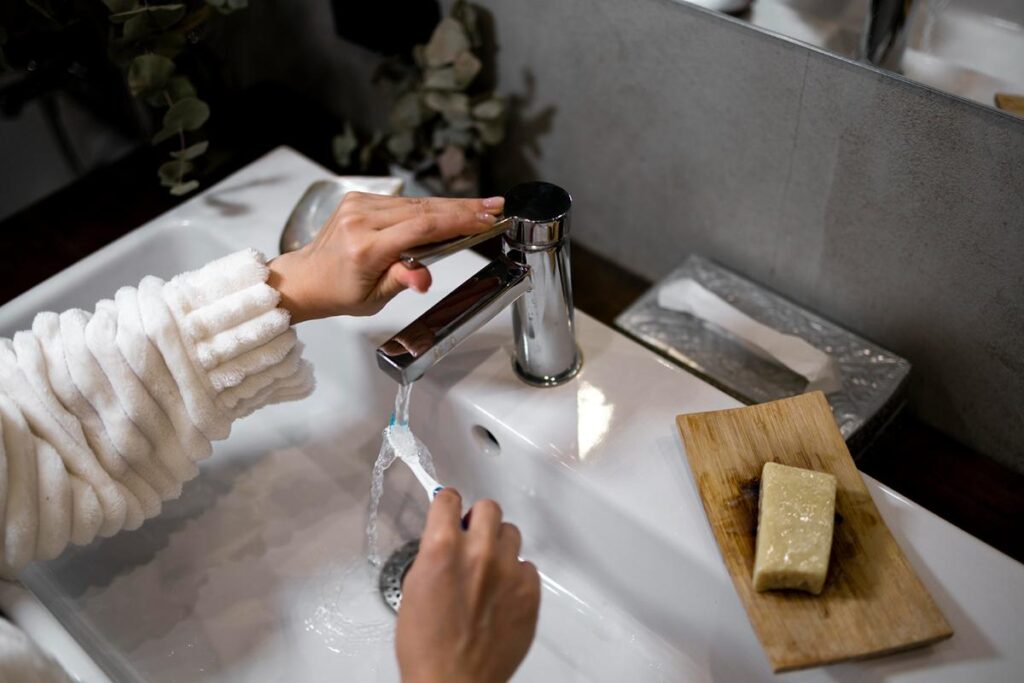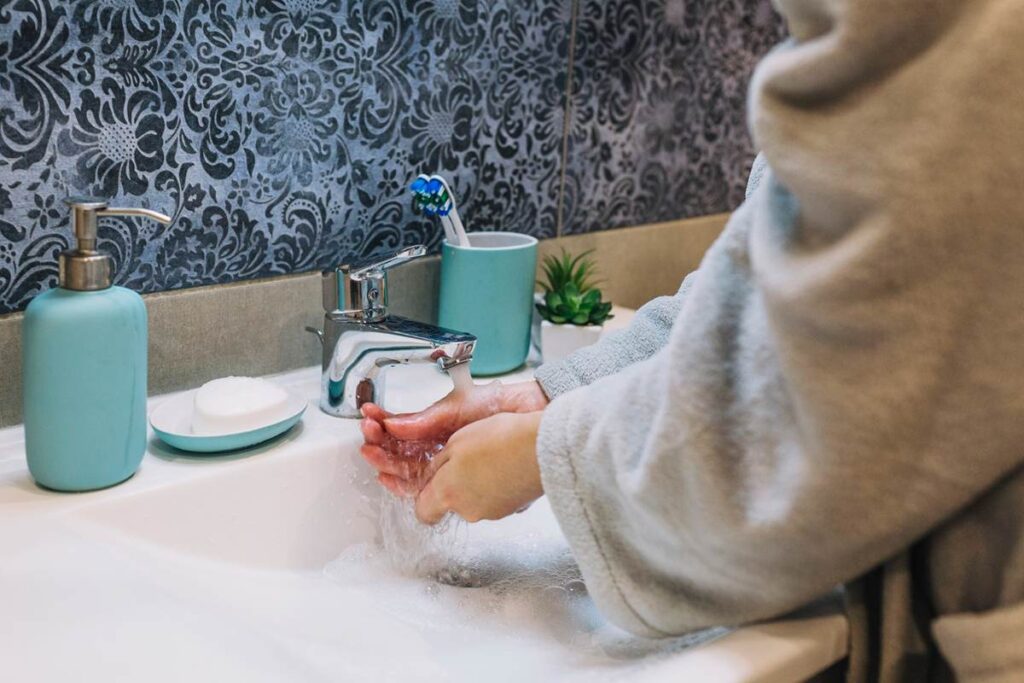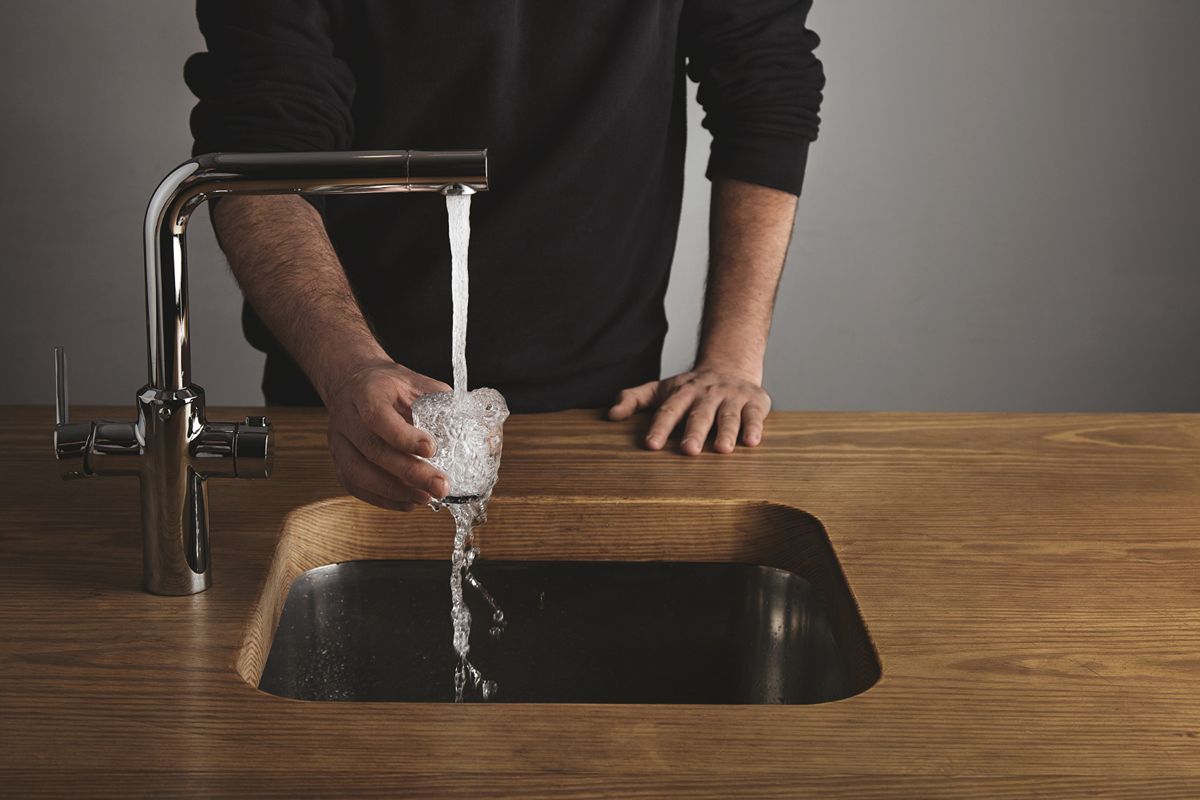Many people ask, “Is bathroom sink water safe to drink?”—especially kids, guests, or anyone brushing their teeth late at night. It’s a common concern in homes across the world, but the answer isn’t always simple. While the water may look clean, hidden risks could be flowing from your tap. In this article, we’ll explore if bathroom sink water is truly safe to drink, how it compares to kitchen tap water, and what steps you can take to stay safe. From expert advice to simple safety tips, we’ll give you clear answers you can trust.
Is Bathroom Sink Water Safe to Drink?
Bathroom sink water comes from the same source as your kitchen tap water—usually your home’s main water supply, which is treated with chlorine to kill bacteria and ensure safety. However, the quality of bathroom sink water can sometimes be different due to various factors related to your plumbing system.
The condition of your pipes plays a big role in how clean the water is. Older pipes, especially those made from lead or corroded materials, can leak harmful metals into your drinking water. Lead in pipes is a significant concern, as it can cause serious health problems, especially for children. Even if your pipes are newer, water can pick up bacteria or contaminants if it sits too long in the pipes, particularly in bathrooms that aren’t regularly used.
Additionally, while chlorine treatment is effective in preventing most bacterial growth, it’s not perfect, and it doesn’t remove all potential pollutants. This means that even though bathroom tap water might be safe for occasional washing or brushing your teeth, it’s important to consider water quality concerns before drinking directly from the sink. If you rely on clean tap water for drinking, it’s best to use water that’s come directly from the kitchen tap, where plumbing tends to be newer and more frequently used.
Is Bathroom Tap Water Safe to Drink in the USA?
In the United States, public tap water is regulated by the U.S. Environmental Protection Agency (EPA) to ensure safety. The Safe Drinking Water Act (SDWA) mandates that public water systems meet specific standards for contaminants. These standards are designed to protect human health by limiting the levels of harmful substances in drinking water.
However, the safety of bathroom tap water can vary based on several factors. In older homes, plumbing systems may include materials like lead pipes or solder, which can leach lead into the water supply. Lead exposure is particularly dangerous for young children and pregnant women.
Factors Affecting the Safety of Bathroom Tap Water:
- House Age: Older homes may have plumbing systems that are more susceptible to corrosion and contamination.
- Plumbing Material: The type of pipes used (e.g., lead, copper, PVC) can influence water quality.
- Water Filter Usage: Homes without water filtration systems may have higher levels of contaminants.
To ensure the safety of bathroom tap water, it’s advisable to:
- Use certified water filters that can remove contaminants.US EPA
- Regularly maintain plumbing systems to prevent corrosion and buildup.
- Consult local water quality reports to stay informed about potential issues.
Is Bathroom Water Safe to Drink in London?

In London, tap water is regulated by strict water quality standards set by Ofwat, the government authority overseeing the water sector. These regulations ensure that public water supplies meet high safety standards, making drinking tap water in London generally safe. However, the situation can vary depending on the type of plumbing system in the home.
In the UK, water can be delivered through two main systems: direct and indirect. Direct systems draw water directly from the mains supply to the taps, ensuring cleaner, fresher water. On the other hand, indirect systems use storage tanks, which can sometimes become contaminated over time, particularly in older homes. These tanks may harbor bacteria or other impurities if not regularly cleaned or maintained.
Risks of Storage Tanks in Older London Homes
In older homes, storage tanks are common, and they can pose a risk to water quality. If these tanks have not been properly maintained, they may collect dirt, algae, or even bacteria. This could affect the water quality from your bathroom taps, making it less safe for drinking.
Bolded Safety Tips for UK Residents:
- Let the tap run for 30 seconds: This helps flush out any stagnant water sitting in the pipes, improving water quality.
- Avoid first morning water: Water that has sat in the pipes overnight can collect impurities. It’s safer to wait a few moments before drinking.
Is Bathroom Water the Same as Kitchen Water?
There’s often confusion about whether bathroom sink water is the same as kitchen tap water. While both sources come from the same water supply, there are important differences that can affect water quality and safety.
In most modern homes, both bathroom and kitchen water are generally safe to drink. However, several factors can influence the water’s quality, such as the location of the pipes, the type of plumbing system, and how often the taps are used.
To clarify the differences, here’s a comparison table:
| Feature | Bathroom Sink Water | Kitchen Tap Water |
| Piping Location | Closer to storage tanks | Direct to mains |
| Common Use | Brushing, washing | Cooking, drinking |
| Risk of Contaminants | Slightly higher | Lower |
As you can see, bathroom water tends to be more exposed to risks like bacteria and contaminants due to its proximity to storage tanks, while kitchen water is often fresher because it’s directly connected to the mains.
In many modern homes, both bathroom and kitchen tap water are treated equally and can be safe to drink. However, it’s essential to consider the context of your home’s plumbing system. If your bathroom water comes from an indirect system or has been sitting in pipes for a long time, it’s always safer to use kitchen tap water for drinking.
Hidden Dangers Most People Miss

When it comes to bathroom sink water, most people assume it’s safe, especially if the water looks clean. However, there are hidden risks that many overlook, which could affect water quality. These overlooked issues are often not discussed in competitor articles, but they are crucial for ensuring that your water is as safe as possible.
1. Stagnant Water in Unused Bathrooms
One of the most common overlooked risks is stagnant water. If a bathroom sink isn’t frequently used, water can sit in the pipes for days or even weeks. This standing water can pick up contaminants from the plumbing or surrounding environment, making it unsafe to drink. It’s always a good practice to run the tap for at least 30 seconds if the bathroom hasn’t been used in a while to flush out any stagnant water.
2. Mold or Mildew in Old Tap Aerators
Over time, mold and mildew can accumulate in the tap aerators — the small mesh devices at the end of your faucet. If not cleaned regularly, these aerators can trap moisture, providing an ideal breeding ground for mold. When you turn on the tap, you may unknowingly release mold spores into the water, which can pose health risks. It’s recommended to clean or replace aerators every 6 to 12 months.
3. Micro-Cracks in Ceramic Pipes (Rare, But Possible)
While not common, micro-cracks in ceramic pipes can develop over time, particularly in older homes. These tiny cracks may allow contaminants or particles to enter the water supply, potentially compromising its safety. Although this is a rare issue, it’s something to be mindful of if you live in an older property with ceramic plumbing.
Expert Advice:
Plumbers and water testing labs agree that regularly maintaining your plumbing system and keeping taps clean are essential to ensuring safe drinking water. According to Water Quality Association (WQA) experts, installing point-of-use water filters and having your water tested by a professional can significantly improve water quality, especially in older homes or areas with water contamination concerns (source).
How to Make Bathroom Tap Water Safer
Ensuring that your bathroom tap water is safe to drink doesn’t have to be complicated. By following a few simple steps, you can significantly reduce the risks associated with bathroom water. Here are easy-to-follow actions to improve the safety of your tap water:
1. Run the Water for 10–30 Seconds
Before using your bathroom tap water for drinking, it’s essential to flush the pipes. Let the water run for 10–30 seconds to clear out any stagnant water that may have been sitting in the pipes. This is particularly important if the bathroom hasn’t been used for a while. By doing this, you’ll reduce the chances of contaminants or bacteria entering your glass.
2. Install a Faucet Filter
One of the most effective ways to improve water quality is by installing a faucet water filter. These filters can remove chlorine, lead, bacteria, and other harmful substances, providing you with cleaner and safer drinking water. There are various filter options available, from simple attachments to more advanced filtration systems, depending on your needs.
3. Test Your Water with a Home Kit
Testing your water regularly is crucial for ensuring that it’s safe to drink. You can purchase home water testing kits that allow you to check for harmful substances like lead, chlorine, or pesticides. These kits are relatively easy to use and give you peace of mind knowing exactly what’s in your tap water. If any issues are found, you can address them promptly by installing additional filtration or contacting a professional.
4. Clean Your Tap Aerators Monthly
Tap aerators can trap dirt, grime, and even bacteria over time. To ensure they don’t negatively affect water quality, make sure to clean your aerators at least once a month. Simply unscrew the aerator from the faucet, soak it in vinegar or a cleaning solution to remove build-up, and rinse thoroughly. This simple step helps to keep your water flowing clean and free from potential contaminants.
Expert Opinions and Scientific Facts
When it comes to the safety of bathroom tap water, expert opinions and scientific studies provide crucial insights that can guide our understanding. Below are some key facts and expert perspectives that reinforce the importance of ensuring safe drinking water in your home.
1. CDC’s Stance on Water Safety
The Centers for Disease Control and Prevention (CDC) emphasizes that while most tap water in the U.S. is safe to drink, it can be contaminated by pollutants if the plumbing system is old or damaged. According to the CDC, water in homes with lead pipes can pose significant health risks, especially to children. The agency recommends regular testing of drinking water, particularly in older homes, to avoid potential exposure to harmful substances.
2. WHO Guidelines on Drinking Water
The World Health Organization (WHO) provides international standards for safe drinking water. WHO reports that water quality is influenced by several factors, including bacterial contamination and the presence of chemical pollutants. They recommend that homes use filtration systems, particularly in areas where tap water might be more prone to contamination due to aging infrastructure .
3. Lead Poisoning and Its Impact
A significant concern related to bathroom sink water is lead poisoning. According to a study by the Environmental Protection Agency (EPA), lead can leach into water from older plumbing systems, especially if pipes have corroded. The CDC reported that lead exposure can cause developmental delays in children and other health problems in adults. In fact, cases of lead poisoning in households with older plumbing systems have been a major public health issue in recent years.
4. Bacterial Contamination Found in Studies
Recent studies have shown that bacteria such as E. coli can occasionally be found in tap water, particularly in areas with older pipes or stagnant water. According to research by the American Water Works Association (AWWA), bacteria can accumulate in unused bathroom taps, especially in buildings that haven’t undergone regular plumbing maintenance. This can pose a serious risk if people drink untreated bathroom tap water. Experts recommend running the tap for at least 30 seconds to help prevent this issue.
Credibility & Resources
To boost the credibility of your water quality, it’s essential to link to high-authority sources like the CDC, WHO, and EPA in your articles. This demonstrates your commitment to providing accurate, scientifically-backed information. Additionally, sharing expert opinions helps establish your website as a trusted source of information on water safety.
Here are some trusted sources for further reading on water safety:
- Centers for Disease Control and Prevention (CDC): CDC on Water Quality
- World Health Organization (WHO): WHO Guidelines for Drinking Water
- Environmental Protection Agency (EPA): EPA Water Safety Information
When It’s Definitely NOT Safe to Drink

Even though bathroom sink water might seem clean, there are times when it’s definitely not safe to drink. Recognizing the warning signs can help protect your health and your family’s well-being.
Here are some clear red flags to watch out for:
Brown or Cloudy Water
If the water looks brown, yellow, or cloudy, it could mean there’s rust, dirt, or bacteria in the pipes. This kind of water is not safe to drink and may signal issues with your home’s plumbing or the local water supply.
Metallic or Chlorine Smell
Water that smells like metal or chemicals might have excess iron, lead, or high levels of chlorine. While chlorine is used to disinfect water, too much of it can irritate your stomach and cause other health problems.
Very Old Plumbing
Homes built before the 1980s may have lead or galvanized pipes, which can slowly release harmful metals into the water over time. This is especially risky if you’re drinking from an older bathroom tap that hasn’t been used or maintained regularly.
Water from Unused Guest Bathrooms
Unused taps can let water sit still in the pipes, making it stagnant. Stagnant water may grow bacteria or mold, especially if the bathroom hasn’t been cleaned or run in a while. It’s always best to run the water for a few seconds before using it.
FAQs: Is Bathroom Sink Water Safe to Drink?
1. Can you drink water from your bathroom sink?
Yes, you can drink bathroom sink water in many modern homes if the plumbing is safe. However, older pipes or rarely used taps may affect the quality. It’s better to test it or use a faucet filter.
2. Is bathroom sink water the same as kitchen sink water?
In most homes, both taps get water from the same main supply. But bathroom water may pass through different pipes or storage tanks. That’s why it may taste different or carry slight risk.
3. Is it safe to drink water from a public bathroom sink?
It’s not recommended to drink from public bathroom sinks. The taps may not be cleaned regularly, and water pipes might not meet drinking standards. Always go for filtered or bottled water when outside.
4. How do I know if my sink water is safe to drink?
Check for odd smells, cloudiness, or discoloration. You can also use a home water testing kit for better peace of mind. If unsure, avoid drinking and consult a plumber or local authority.
5. Is bathroom water safe to drink if boiled?
Boiling bathroom tap water can kill most bacteria or germs. But it won’t remove heavy metals like lead from old pipes. Use filtration along with boiling for the safest results.
6. Why does bathroom tap water taste different?
It may taste different due to pipe materials or standing water in less-used taps. Minerals or chlorine levels can also affect the flavor. Letting the water run can help improve taste.
7. Can kids drink bathroom sink water safely?
It’s generally okay in clean, modern homes, but kids are more sensitive to contaminants. Use filtered or kitchen water for kids whenever possible to be extra safe.
8. What’s the best way to make bathroom water safe for drinking?
Use a certified faucet filter and clean your tap aerators monthly. Running the water for 20–30 seconds also helps flush out standing water and improves safety.
Conclusion
So, is bathroom sink water safe to drink? The answer depends on several things — the age of your home, the condition of your plumbing, and how often the tap is used.
In most modern homes, bathroom tap water comes from the same clean source as the kitchen. However, bathroom pipes and fixtures might cause changes in taste or increase the chance of contamination, especially in older homes or guest bathrooms that are rarely used.
To stay safe:
- Use a faucet filter or test your water to know for sure.
- Let the water run for a few seconds before drinking.
- Avoid drinking water that looks, smells, or tastes strange.










